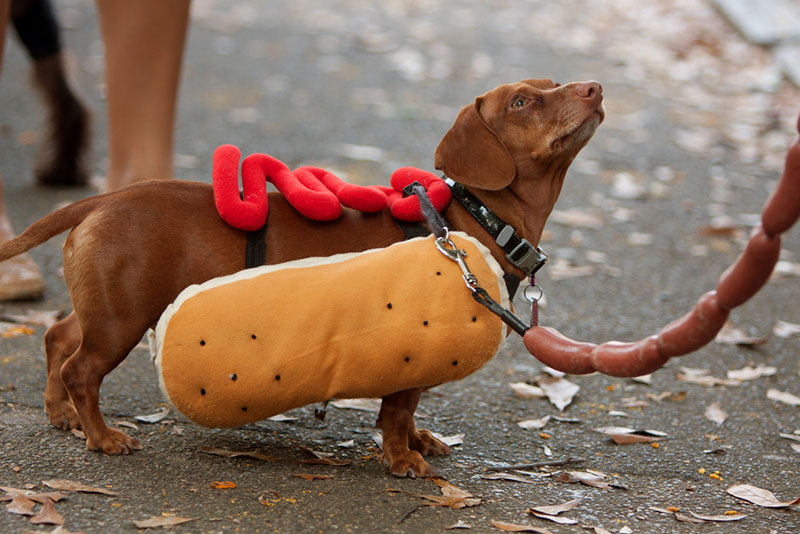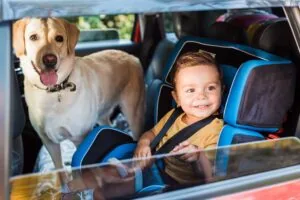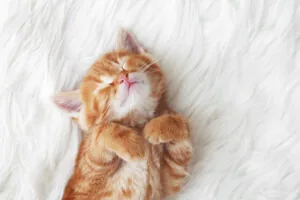Halloween Safety Tips for Pets

Halloween can be a festive and fun time for children and families. But for pets? Let’s face it, it can be a little scary. Forgo the stress and dangers this year by following these easy tips.
Trick-or-treat candies are not for pets
All forms of chocolate (especially baking or dark chocolate) can be dangerous, even lethal, for dogs and cats. Symptoms of chocolate poisoning may include vomiting, diarrhea, rapid breathing, increased heart rate, and seizures. Halloween candies containing the artificial sweetener xylitol can also be poisonous to dogs. Even small amounts of xylitol can cause a sudden drop in blood sugar and subsequent loss of coordination and seizures. And while xylitol toxicity in cats has yet to be established, it’s better to be safe than sorry. If you suspect your dog has eaten something harmful you may call the ASPCA Animal Poison Control Center (888-426-4435) or Pet Poison Helpline (855-764-7661) 24 hours a day, year-round. Also identify in advance the emergency veterinary clinic nearest your home and post that information on your refrigerator beside the poison hotline numbers.
Don’t leave pets out in the yard on Halloween
Vicious pranksters have been known to tease, injure, steal, and even kill pets on Halloween night. Inexcusable? Yes! But preventable nonetheless. Black cats are especially at risk from pranks or other cruelty-related incidents. In fact, many shelters do not adopt out black cats during the month of October as a safety precaution. Make sure your black cats are safely housed indoors around Halloween.
Keep pets confined and away from the door
Indoors is certainly better than outdoors on Halloween, but your door will still be constantly opening and closing, and strangers will be on your doorstep dressed in unusual costumes. This, of course, can be scary for our furry friends, which can result in escape attempts or unexpected aggression. If your pet is wary of strangers or has a tendency to bite, put him in another room during trick-or-treating hours or provide him/her with a safe hiding place. Putting your dog or cat in a secure crate or room away from the front door will reduce stress and prevent them from darting outside into the night. Give your pets a quiet, safe place on Halloween. Scary parties, constant doorbell ringing or too many strangers in your home can be stressful to your four-legged friends and even make them physically ill.
Keep glow sticks away from pets
While glow sticks can help keep people safe on Halloween night, they can add some unwanted drama to the holiday if a pet chews one open. Although the liquid in these products isn’t likely toxic, it tastes really bad and makes pets salivate excessively and act strangely. Pets who get into a glow stick may drool, paw at their mouth, become agitated, and sometimes even vomit. Doctors recommend that if your pet does chew on a glow stick, offer some fresh water or a small meal to help clear the material out of the mouth.
Keep Halloween plants such as pumpkins and corn out of reach
While small amounts of corn and pumpkin can be fed safely to many pets, ingesting uncooked, potentially moldy Halloween pumpkins or corn displays can cause big problems. Gastrointestinal upset is a possibility whenever pets eat something they aren’t used to, and intestinal blockage can occur if large pieces are swallowed. If you are using candles to light your jack-o-lanterns or other Halloween decorations, make sure to place them well out of reach of your pets. Should they get too close, they run the risk of burning themselves or causing a fire.
Keep electric and battery-powered Halloween decorations out of reach
Electric and battery-powered Halloween decorations are certainly safer than open candles, but they still can present a risk to pets. Pets who chew on electrical cords can receive a possibly life-threatening electrical shock or burn. Batteries may cause chemical burns when chewed open or gastrointestinal blockage if swallowed. Shards of glass or plastic can cause lacerations anywhere on the body or, if swallowed, within the gastrointestinal tract.
Pet Costumes
If you plan to put a costume on your pet, make sure it fits properly and is comfortable, doesn’t have any pieces that can easily be chewed off, and doesn’t interfere with your pet’s sight, hearing, breathing, opening its mouth, or moving. Pets who are wearing a costume should always be supervised by a responsible adult so that if something goes wrong, it can be addressed right away. Don’t wait until Halloween night to put your pet in a costume for the first time. Any time you want to introduce your pet to something new, it’s best to go slowly. Get your pet costumes early, and put them on for short periods of time (and piece by piece, if possible). Make it a positive experience by offering lots of praise and treats. If at any time, your pet seems distressed or develops skin problems from contact with a costume, consider that your pet may not want to wear a costume. A festive bandana may be a good compromise.
Microchipping/IDs
If your dog or cat should escape and become lost, having the proper identification will increase the chances that he or she will be returned. Collars and tags are ideal if a Good Samaritan is able to collect your wayward pet, but microchips offer permanent identification should the collar or tag fall off. Just make sure the information is up-to-date. Use Halloween as a yearly reminder to double check your address and phone number on tags and with the company who supports pet microchips. With that front door continuously opening and closing for trick-or-treaters, there is a chance they could run out – especially if they’re spooked. If for any reason your cat or dog does escape when the door is open, proper identification increases the chance of him returning to you.
Make a DIY Spooky Toy
From bones to pumpkins, and mummies to witches, there are plenty of Halloween-themed pet toys. While you can always buy one from a store, you can also make some simple Halloween toys for your pet with items like old t-shirts, felt, old gloves, or socks. Braid and knot together some orange and black fleece strips for your dog, or sew a spooky felt monster for your cat. Even if your pet doesn’t want to wear a costume, they can still tote around a Halloween pet accessory.
Carve a Puppy Pumpkin
To take it a step further, you can decorate your pumpkin in honor of your pet! There are plenty of pet pumpkin carving patterns available online, whether you are a novice or professional pumpkin carver.
Tricks for Halloween Pet Treats
Tricks and treats don’t have to be mutually exclusive. Fall is a great time of year to brush up on your pet’s repertoire and a great time of year to incorporate some new tricks and treats into the mix! There are dozens of Halloween-themed pet treats you can make for your dog or cat, including recipes that can use some of the pumpkin left over from carving. From fall flavors to adorable cookie cutouts, you can give your pet a special treat for their new tricks.
Planning ahead can keep your kids and pets safe to enjoy the creepiest holiday of the year. Happy Halloween!
Share This Post
Recent Posts
About Shallowford Animal Hospital
Shallowford Animal Hospital and The Pet Spa at Shallowford are dedicated to the exceptional, compassionate care your pet deserves. Pets hold a very special place in our families, and we treat yours like our own.



